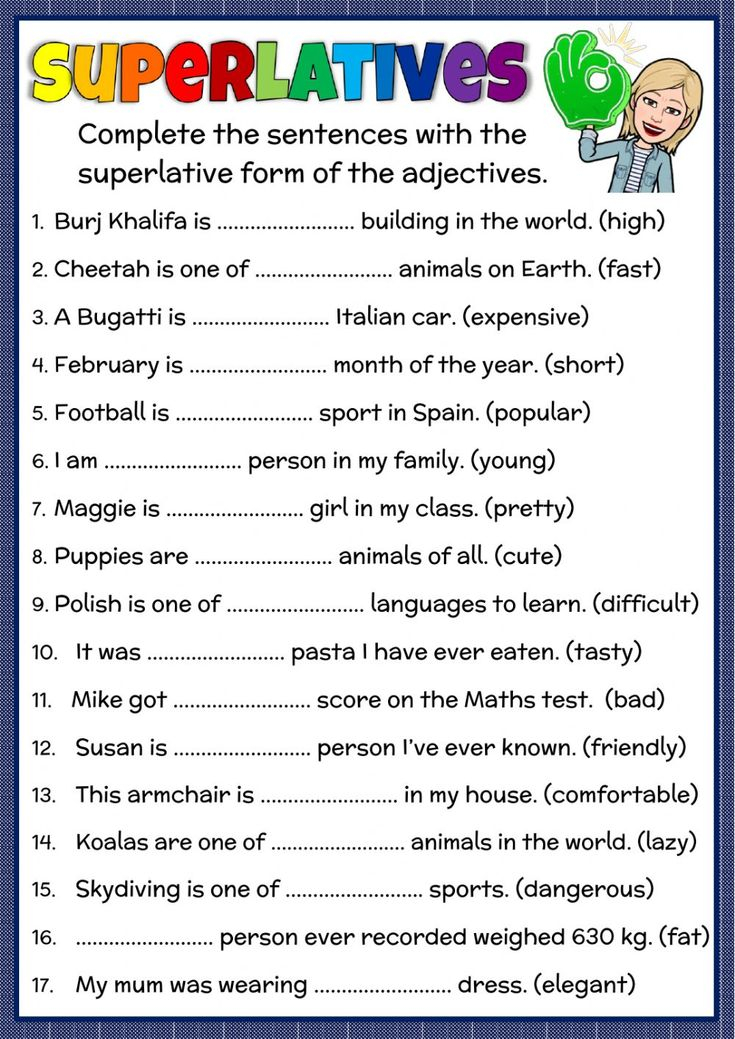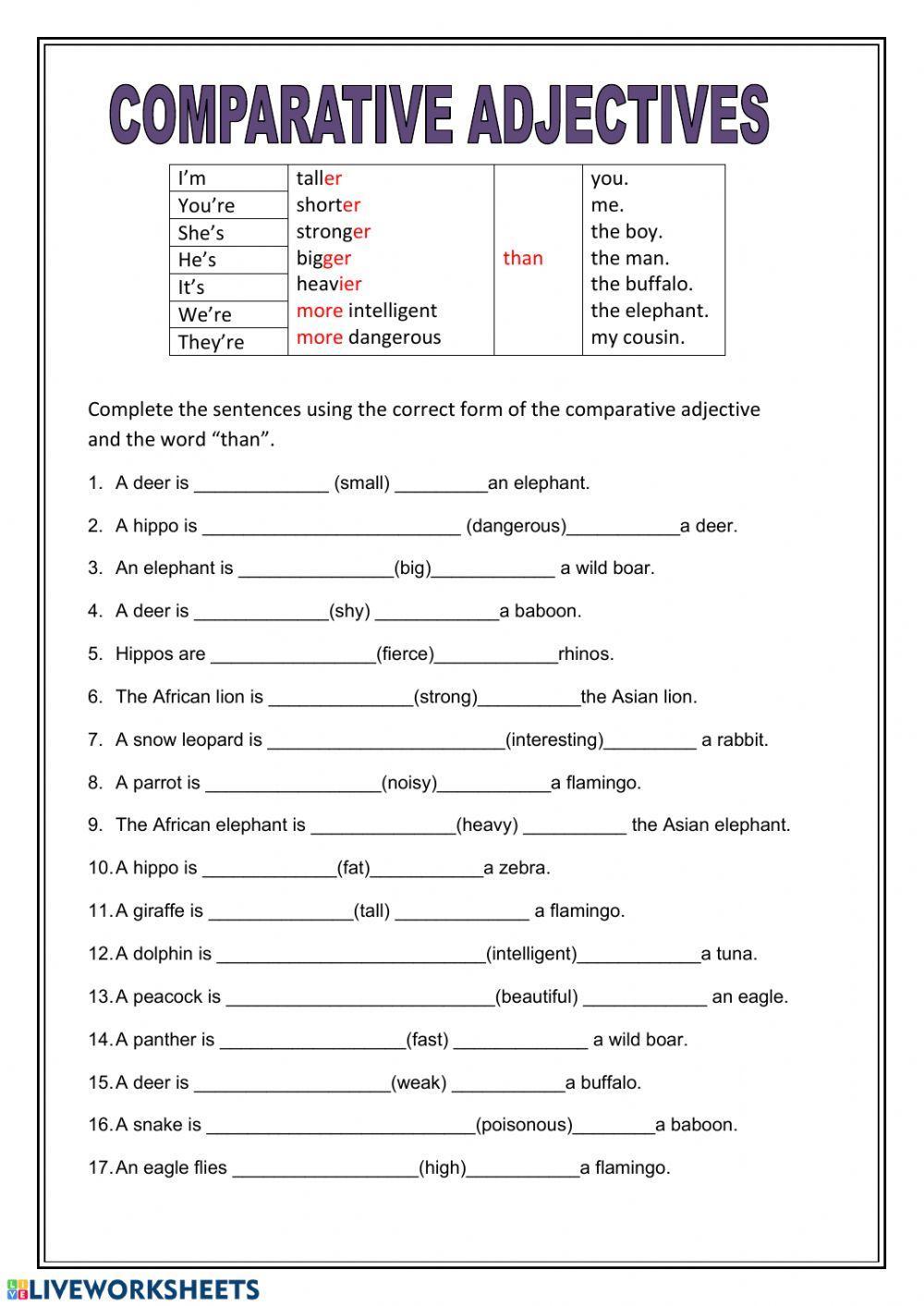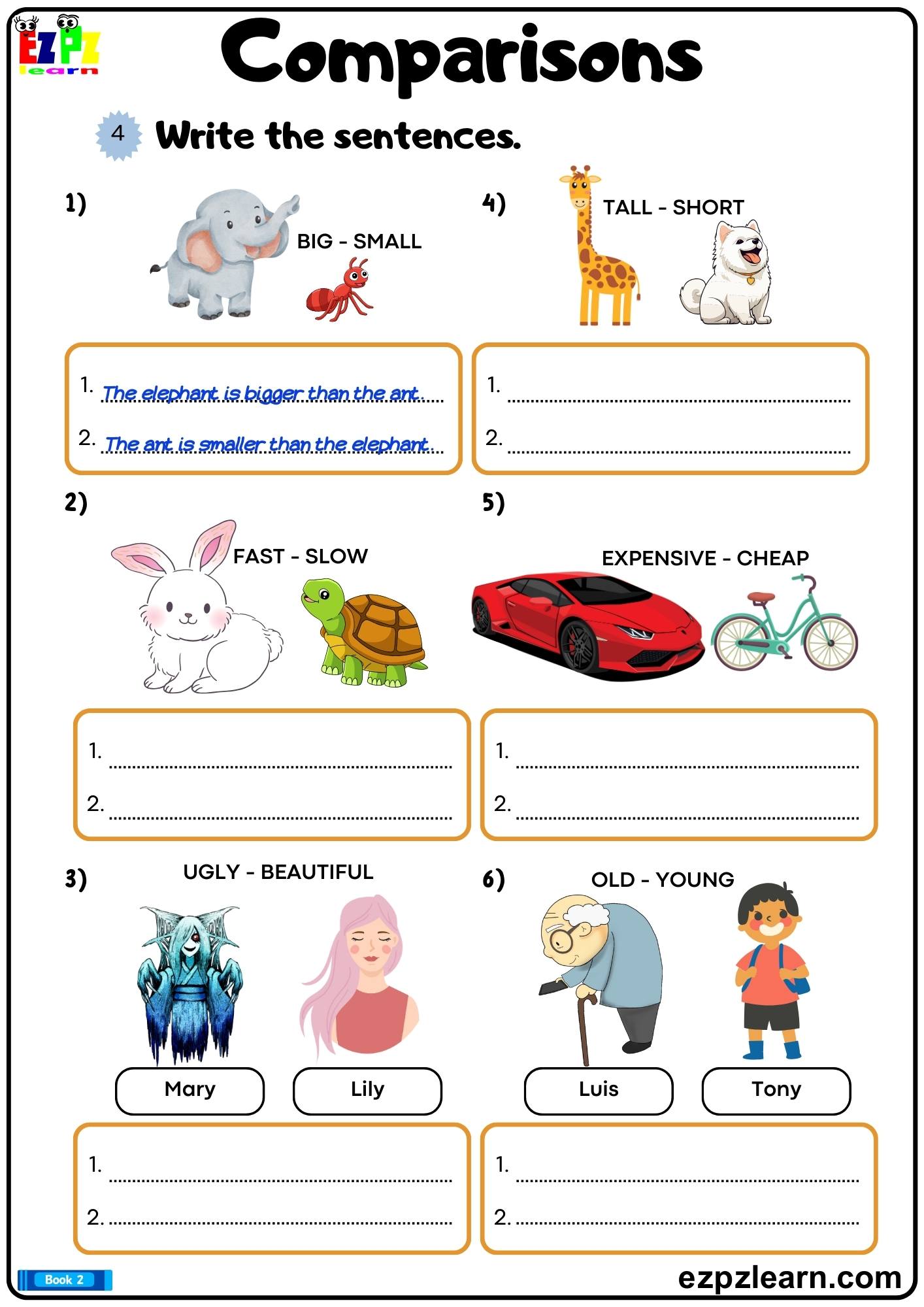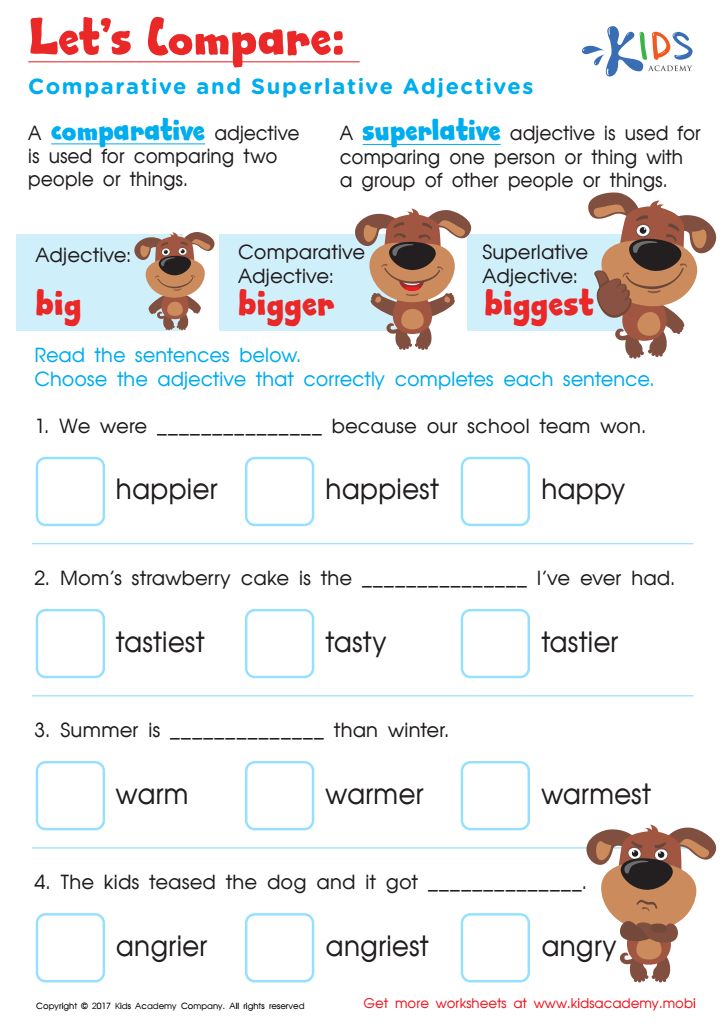
Mastering Extremes: The Indispensable Role of Using Superlative Adjectives Worksheets in Language Acquisition
In the vast landscape of the English language, where nuances of comparison and degrees of description reign supreme, superlative adjectives stand as a pinnacle. They allow us to articulate the highest or lowest degree of a quality within a group, transforming simple statements into vivid declarations of extremes. From "the tallest building" to "the most beautiful song" or "the worst day," superlatives are an integral part of everyday communication, enriching our descriptions and adding precision to our thoughts. However, for many language learners, mastering these forms can be a challenging endeavor, fraught with irregular spellings, tricky rules, and common pitfalls. This is where the strategic and well-designed using superlative adjectives worksheet becomes an invaluable educational tool.
This article delves into the profound benefits and effective strategies for leveraging a using superlative adjectives worksheet as a cornerstone of language education. We will explore what superlative adjectives are, why they are crucial, how an effective worksheet is constructed, the various types of exercises it should contain, and the pedagogical advantages it offers to both learners and educators alike.

What are Superlative Adjectives?

At their core, superlative adjectives are used to compare three or more nouns and identify the one that possesses the highest or lowest degree of a particular quality. They answer the question "which one is the most/least X?"

The formation of superlative adjectives generally follows a few key rules:

-
For most one-syllable adjectives: Add "-est" to the end.
- Old → Oldest
- Fast → Fastest
- Tall → Tallest


-

For one-syllable adjectives ending in a single vowel and a single consonant: Double the final consonant before adding "-est."
- Big → Biggest
- Hot → Hottest
- Thin → Thinnest

-
For two-syllable adjectives ending in "-y": Change the "y" to "i" and add "-est."
- Happy → Happiest
- Funny → Funniest
- Easy → Easiest
-
For most two-syllable adjectives not ending in "-y" and all adjectives with three or more syllables: Use "most" before the adjective.
- Modern → Most modern
- Beautiful → Most beautiful
- Expensive → Most expensive
-
Irregular Superlatives: Some common adjectives have irregular superlative forms that must be memorized.
- Good → Best
- Bad → Worst
- Far → Farthest/Furthest
- Little → Least
- Much/Many → Most

Understanding these rules is the first step, but applying them accurately and confidently requires consistent practice, which is precisely where the structured environment of a worksheet excels.
Why are Superlative Adjectives Important for Language Learners?
Superlative adjectives are not merely grammatical curiosities; they are essential for effective and nuanced communication. Their importance stems from several factors:
- Precision and Detail: They allow speakers and writers to be highly specific, distinguishing one item or person as unique within a group based on a particular attribute. Instead of saying "That building is tall," one can say "That is the tallest building in the city," providing much richer information.
- Enhancing Description: Superlatives add vividness and emphasis to descriptions, making language more engaging and impactful. They are crucial for storytelling, expressing opinions, and creating compelling narratives.
- Common Usage: From news headlines to casual conversations, advertising slogans to academic papers, superlatives are pervasive in English. A learner who cannot correctly form and use them will find their expressive capabilities significantly limited.
- Foundational Grammar: Mastery of superlatives builds upon and reinforces understanding of adjectives in general, as well as comparative forms, contributing to a more robust grammatical foundation.
While theoretical understanding is crucial, practical application is where true mastery is forged. This is why the deliberate act of using superlative adjectives worksheet becomes a critical bridge between knowing the rules and applying them fluently.
Designing an Effective Using Superlative Adjectives Worksheet
An ideal using superlative adjectives worksheet is not merely a collection of questions; it is a thoughtfully designed pedagogical tool that guides learners through the complexities of superlative formation and usage. A comprehensive worksheet should include:
- Clear Instructions and Examples: Before plunging into exercises, the worksheet should briefly reiterate the rules for forming superlatives, accompanied by clear, concise examples for each category (one-syllable, two-syllable ending in -y, multi-syllable, and irregulars). This serves as a quick review and reference point.
- Varied Exercise Types: To cater to different learning styles and reinforce understanding from multiple angles, a good worksheet incorporates a range of exercise formats.
- Gradual Difficulty: Exercises should progress from simpler recognition tasks to more complex application and production tasks. This builds confidence and allows learners to consolidate their understanding at each stage.
- Contextual Relevance: Whenever possible, exercises should be embedded in realistic or engaging contexts, making the learning more meaningful and memorable.
- Space for Answers: Ample space should be provided for learners to write their responses clearly.
- Answer Key (Optional for Self-Study): For self-directed learning or homework, an answer key can be invaluable for immediate feedback and self-correction, fostering autonomous learning.
Types of Exercises to Include in a Superlative Adjectives Worksheet
To maximize learning outcomes, a using superlative adjectives worksheet should feature a diverse array of exercises:
-
Basic Formation (Fill-in-the-Blanks):
- Objective: To practice the core rules of adding "-est" or "most."
- Example: "This is the (tall) building in the city." "She is the (beautiful) girl in the class."
-
Sentence Completion:
- Objective: To apply superlatives within a sentence context.
- Example: "Mount Everest is the (high) mountain in the world." "My grandmother tells the (interesting) stories."
-
Sentence Transformation:
- Objective: To convert positive or comparative sentences into superlative ones, requiring a deeper understanding of comparison.
- Example: "No one in the class is as smart as John." → "John is the student in the class." "This book is more exciting than all the others." → "This is the book I’ve ever read."
-
Error Correction:
- Objective: To identify and correct common mistakes, enhancing critical thinking and rule application.
- Example: "She is the most richest person I know." (Incorrect) → "She is the richest person I know." "That was the baddest movie ever." (Incorrect) → "That was the worst movie ever."
-
Picture Prompts/Description:
- Objective: To encourage creative application of superlatives in descriptive writing.
- Example: Provide a picture of a group of animals with varying sizes, speeds, etc., and ask learners to write sentences using superlatives (e.g., "The elephant is the biggest animal." "The cheetah is the fastest.").
-
Real-World Scenarios/Opinion-Based Questions:
- Objective: To make learning relevant and encourage personal expression.
- Example: "What is the (good) movie you’ve seen recently?" "Who is the (talented) musician in your country?" "What is the ___ (difficult) subject you study?"
-
Short Paragraph Writing:
- Objective: To integrate superlatives into longer forms of writing, demonstrating comprehensive understanding.
- Example: "Write a short paragraph describing your dream vacation, using at least five superlative adjectives."
Benefits of Using Superlative Adjectives Worksheet
Beyond the immediate practice, a well-structured using superlative adjectives worksheet offers numerous pedagogical advantages for both learners and educators:
- Active Learning: Worksheets require learners to actively engage with the material, rather than passively receiving information. This hands-on approach deepens understanding and retention.
- Targeted Practice: They allow learners to focus specifically on superlative forms, addressing common areas of difficulty without distraction.
- Immediate Feedback: When used in class with teacher supervision or with an answer key, worksheets provide instant feedback, allowing learners to identify and correct errors promptly. This prevents the reinforcement of incorrect forms.
- Reinforcement and Consolidation: Repetitive yet varied exercises solidify grammatical rules and vocabulary, moving knowledge from short-term to long-term memory.
- Confidence Building: Successfully completing exercises builds confidence in learners’ abilities, encouraging them to use superlatives more freely in spoken and written communication.
- Caters to Different Learning Styles: Worksheets can appeal to visual learners (seeing the words), kinesthetic learners (writing the answers), and logical learners (applying rules).
- Assessment Tool: For teachers, completed worksheets provide a quick and effective way to assess individual and class-wide understanding, identifying areas that may require further instruction.
- Self-Paced Learning: Worksheets can be completed at a learner’s own pace, making them suitable for differentiated instruction or homework assignments.
Tips for Teachers and Learners When Using Superlative Adjectives Worksheets
To maximize the effectiveness of a using superlative adjectives worksheet, consider these tips:
For Teachers:
- Pre-teach and Review: Before assigning the worksheet, ensure students have a foundational understanding of adjectives and the basic rules for superlatives.
- Scaffolding: Start with simpler exercises and gradually introduce more complex ones. Provide examples for each section.
- Encourage Collaboration: Allow students to work in pairs or small groups for some exercises, fostering peer learning and discussion.
- Provide Constructive Feedback: Don’t just mark answers right or wrong. Explain why an answer is incorrect and guide students to the correct form.
- Follow-up Activities: Integrate the worksheet practice with speaking or writing activities where students have to use superlatives spontaneously. For example, a debate on "the most important invention" or describing "the most memorable trip."
- Make it Fun: Incorporate games or competitive elements when reviewing answers to keep engagement high.
For Learners:
- Read Instructions Carefully: Ensure you understand what each exercise requires before you begin.
- Refer to Rules: If unsure, refer back to the rules section of the worksheet or your grammar notes.
- Don’t Be Afraid of Mistakes: Mistakes are part of the learning process. Use them as opportunities to understand better.
- Review Your Answers: If an answer key is provided, use it to check your work and understand your errors.
- Practice Regularly: Consistency is key. The more you practice, the more natural superlative usage will become.
- Apply in Real Life: Try to use superlatives in your daily conversations or writing outside of the worksheet.
Conclusion
Superlative adjectives are a powerful linguistic tool, enabling us to describe the world with unparalleled precision and emphasis. Their mastery is not just about grammatical correctness; it’s about unlocking a richer, more expressive way of communicating in English. The journey to mastering superlative adjectives is significantly aided by a well-designed and strategically implemented using superlative adjectives worksheet.
By providing structured, targeted, and varied practice, these worksheets bridge the gap between theoretical knowledge and practical application. They empower learners to confidently navigate the intricacies of superlative formation, identify and correct common errors, and ultimately, integrate these powerful adjectives seamlessly into their everyday language. Embrace the power of these targeted tools, for in the realm of language acquisition, a comprehensive using superlative adjectives worksheet is truly one of the most effective paths to success.
